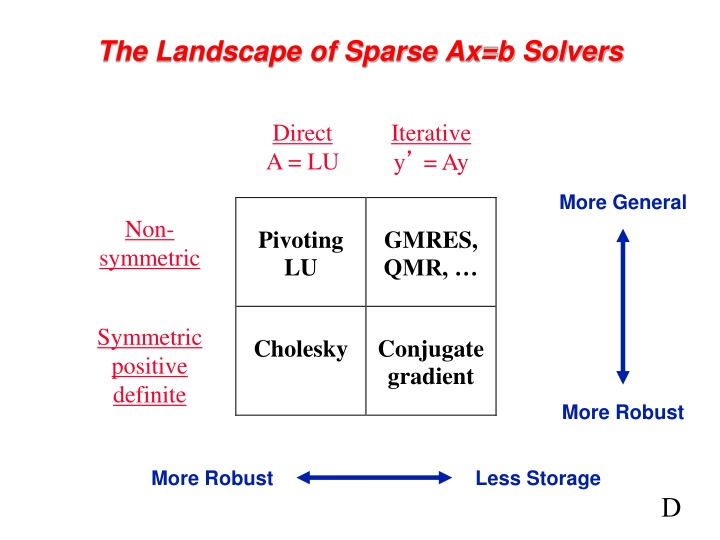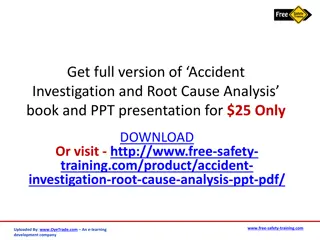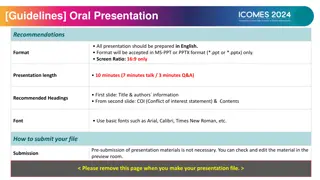
Sparse Ax=b Solvers and Cholesky Factorization
Discover the landscape of sparse Ax=b solvers, from direct solvers like LU to iterative methods such as GMRES and QMR. Explore Cholesky factorization techniques, including both general and sparse column approaches. Learn about sparse Gaussian elimination, Chordal completion, and the Cholesky graph game. Dive into the world of graphs and sparse matrices, symmetric Gaussian elimination, and the path lemma.
Download Presentation

Please find below an Image/Link to download the presentation.
The content on the website is provided AS IS for your information and personal use only. It may not be sold, licensed, or shared on other websites without obtaining consent from the author. If you encounter any issues during the download, it is possible that the publisher has removed the file from their server.
You are allowed to download the files provided on this website for personal or commercial use, subject to the condition that they are used lawfully. All files are the property of their respective owners.
The content on the website is provided AS IS for your information and personal use only. It may not be sold, licensed, or shared on other websites without obtaining consent from the author.
E N D
Presentation Transcript
The Landscape of Sparse Ax=b Solvers Direct A = LU Iterative y = Ay More General Non- Pivoting LU GMRES, QMR, symmetric Symmetric positive definite Cholesky Conjugate gradient More Robust More Robust Less Storage D
Column Cholesky Factorization for j = 1 : n j L(j:n, j) = A(j:n, j); for k = 1 : j-1 % cmod(j,k) L(j:n, j) = L(j:n, j) L(j, k) * L(j:n, k); end; LT L A % cdiv(j) L(j, j) = sqrt(L(j, j)); L(j+1:n, j) = L(j+1:n, j) / L(j, j); L end; Column j of A becomes column j of L
Sparse Column Cholesky Factorization for j = 1 : n j L(j:n, j) = A(j:n, j); for k < j with L(j, k) nonzero % sparse cmod(j,k) L(j:n, j) = L(j:n, j) L(j, k) * L(j:n, k); end; LT L A % sparse cdiv(j) L(j, j) = sqrt(L(j, j)); L(j+1:n, j) = L(j+1:n, j) / L(j, j); L end; Column j of A becomes column j of L
Sparse Gaussian elimination and chordal completion [Parter, Rose] 3 3 1 1 2 2 4 4 5 5 Ax = b A = L1L1T 5 5 2 2 3 3 4 4 1 1 (PAPT) (Px) = (Pb) PAPT = L2L2T
Cholesky Graph Game Given an undirected graph G = G(A), Repeat: Choose a vertex v and mark it; Add edges between unmarked neighbors of v; Until every vertex is marked Goal: End up with as few edges as possible. Output: A labeling of the vertices with numbers 1 to n, corresponding to a symmetric permutation of matrix A.
Graphs and Sparse Matrices: Cholesky factorization Fill: new nonzeros in factor 3 3 7 7 1 1 Symmetric Gaussian elimination: for j = 1 to n add edges between j s higher-numbered neighbors 6 6 8 8 4 4 10 10 9 2 9 2 5 5 G+(A) [chordal] G(A)
Path lemma [Davis Thm 4.1] Let G = G(A) be the graph of a symmetric, positive definite matrix, with vertices 1, 2, , n, and let G+ = G+(A)be the filled graph. Then (v, w) is an edge of G+ if and only if G contains a path from v to w of the form (v, x1, x2, , xk, w) with xi < min(v, w) for each i. (This includes the possibility k = 0, in which case (v, w) is an edge of G and therefore of G+.)
Elimination Tree 3 10 7 1 9 5 6 8 4 8 2 4 10 7 3 6 9 2 1 5 G+(A) T(A) Cholesky factor T(A) : parent(j) = min { i > j : (i, j) inG+(A) } parent(col j) = first nonzero row below diagonal in L T describes dependencies among columns of factor Can compute G+(A) easily from T Can compute T from G(A) in almost linear time
Facts about elimination trees If G(A) is connected, then T(A) is connected (it s a tree, not a forest). If A(i, j) is nonzero and i > j, then i is an ancestor of j in T(A). If L(i, j) is nonzero, then i is an ancestor of j in T(A). [Davis Thm 4.4] T(A) is a depth-first spanning tree of G+(A). T(A) is the transitive reduction of the directed graph G(LT).
Permutations for sparsity I observed that most of the coefficients in our matrices were zero; i.e., the nonzeros were sparse in the matrix, and that typically the triangular matrices associated with the forward and back solution provided by Gaussian elimination would remain sparse if pivot elements were chosen with care - Harry Markowitz, describing the 1950s work on portfolio theory that won the 1990 Nobel Prize for Economics
Sparse Gaussian elimination and chordal completion [Parter, Rose] Repeat: Choose a vertex v and mark it; Add edges between unmarked neighbors of v; Until: Every vertex is marked Goal: End up with as few edges as possible. Equivalently: Add as few edges as possible to make the graph chordal. (Note for later: Fewest edges is not the only interesting objective.)
The (2-dimensional) model problem n1/2 Graph is a regular square grid with n = k2 vertices. Corresponds to matrix for regular 2D finite difference mesh. Gives good intuition for behavior of sparse matrix algorithms on many 2-dimensional physical problems. There s also a 3-dimensional model problem.
Permutations of the 2-D model problem Theorem 1: With the natural permutation, the n-vertex model problem has exactly O(n3/2) fill. Theorem 2: With a nested dissection permutation, the n-vertex model problem has exactly O(n log n) fill. Theorem 3: With any permutation, the n-vertex model problem has at least O(n log n) fill. See course notes for proofs.
Nested dissection ordering A separator in a graph G is a set S of vertices whose removal leaves at least two connected components. A nested dissection ordering for an n-vertex graph G numbers its vertices from 1 to n as follows: Find a separator S, whose removal leaves connected components T1, T2, , Tk Number the vertices of S from n-|S|+1 to n. Recursively, number the vertices of each component: T1 from 1 to |T1|, T2 from |T1|+1 to |T1|+|T2|, etc. If a component is small enough, number it arbitrarily. It all boils down to finding good separators!
Separators in theory If G is a planar graph with n vertices, there exists a set of at most sqrt(6n) vertices whose removal leaves no connected component with more than 2n/3 vertices. ( Planar graphs have sqrt(n)-separators. ) Well-shaped finite element meshes in 3 dimensions have n2/3 - separators. Also some other classes of graphs trees, graphs of bounded genus, chordal graphs, bounded-excluded- minor graphs, Mostly these theorems come with efficient algorithms, but they aren t used much.
Separators in practice Graph partitioning heuristics have been an active research area for many years, often motivated by partitioning for parallel computation. See CS 240A. Some techniques: Spectral partitioning (uses eigenvectors of Laplacian matrix of graph) Geometric partitioning (for meshes with specified vertex coordinates) Iterative-swapping (Kernighan-Lin, Fiduccia-Matheysses) Breadth-first search (fast but dated) Many popular modern codes (e.g. Metis, Chaco) use multilevel iterative swapping Matlab graph partitioning toolbox: see course web page
Permutations of general 2D and 3D problems Theorem 4: With a nested dissection permutation, any planar graph with n vertices has at most O(n log n) fill. Theorem 5: With a nested dissection permutation, any 3D finite element mesh (with a technical condition on element shapes) has at most O(n 4/3 ) fill. See course notes for references to proofs.
Heuristic fill-reducing matrix permutations Nested dissection: Find a separator, number it last, proceed recursively Theory: approx optimal separators => approx optimal fill and flop count Practice: often wins for very large problems Minimum degree: Eliminate row/col with fewest nzs, add fill, repeat Hard to implement efficiently current champion is Approximate Minimum Degree [Amestoy, Davis, Duff] Theory: can be suboptimal even on 2D model problem Practice: often wins for medium-sized problems Banded orderings (Reverse Cuthill-McKee, Sloan, . . .): Try to keep all nonzeros close to the diagonal Theory, practice: often wins for long, thin problems The best modern general-purpose orderings are ND/MD hybrids.
Fill-reducing permutations in Matlab Symmetric approximate minimum degree: p = amd(A); symmetric permutation: chol(A(p,p)) often sparser than chol(A) Symmetric nested dissection: not built into Matlab several versions in meshpart toolbox (course web page references) Nonsymmetric approximate minimum degree: p = colamd(A); column permutation: lu(A(:,p)) often sparser than lu(A) also for QR factorization Reverse Cuthill-McKee p = symrcm(A); A(p,p) often has smaller bandwidth than A similar to Sparspak RCM
Complexity of direct methods Time and space to solve any problem on any well- shaped finite element mesh n1/2 n1/3 2D 3D O(n log n) O(n 4/3 ) Space (fill): O(n 3/2 ) O(n 2 ) Time (flops):
Sparse Cholesky factorization to solve Ax = b 1. Preorder: replace A by PAPT and b by Pb Independent of numerics 2. Symbolic Factorization: build static data structure Elimination tree Nonzero counts Supernodes Nonzero structure of L 3. Numeric Factorization: A = LLT Static data structure Supernodes use BLAS3 to reduce memory traffic 4. Triangular Solves: solve Ly = b, then LTx = y






















